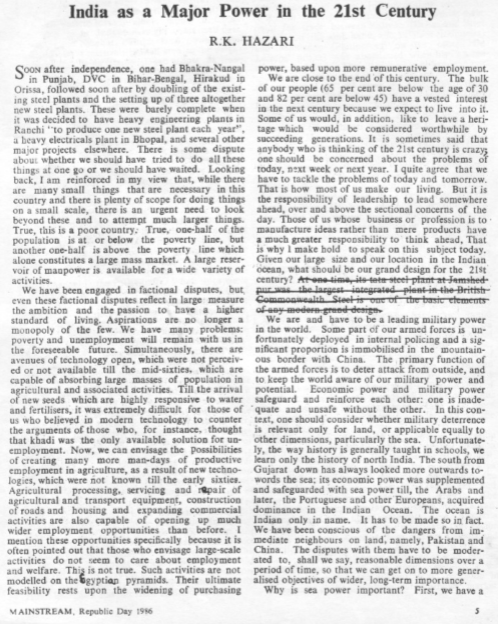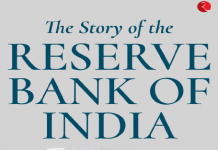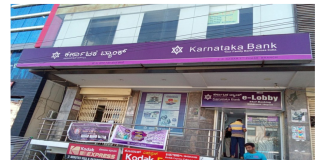Talk delivered by Dr Hazari to the executives of the Tata Iron and Steel at Jamshedpur around 1985
Soon after independence, one had Bhakra-Nangal in Punjab, [Damodar Valley Corporation] DVC in Bihar-Bengal, Hirakud in Orissa, followed soon after by doubling of the existing steel plants and the setting up of three altogether new steel plants. These were barely complete when it was decided to have heavy engineering plants in Ranchi “to produce one new steel plant each year”, a heavy electricals plant in Bhopal, and several other major projects elsewhere. There is some dispute about whether we should have tried to do all these things at one go or we should have waited. Looking back, I am reinforced in my view that, while there are many small things that are necessary in this country and there is plenty of scope for doing things on a small scale, there is an urgent need to look beyond these and to attempt much larger things. True, this is a poor country. True, one-half of the population is at or below the poverty line, but another one-half is above the poverty line which alone constitutes a large mass market. A large reservoir of manpower is available for a wide variety of activities.
We have been engaged in factional disputes, but, even these factional disputes reflect in large measure the ambition and the passion to have a higher standard of living. Aspirations are no longer a monopoly of the few. We have many problems: poverty and unemployment will remain with us in the foreseeable future. Simultaneously, there are avenues of technology open, which were not perceived or not available till the mid-sixties, which are capable of absorbing large masses of population in agricultural and associated activities. Till the arrival of new seeds which are highly responsive to water and fertilisers, it was extremely difficult for those of us who believed in modem technology to counter the arguments of those who, for instance, thought that khadi was the only available solution for un-employment. Now, we can envisage the possibilities of creating many more man-days of productive employment in agriculture, as a result of new technologies, which were not known till the early sixties. Agricultural processing, servicing and repair of agricultural and transport equipment, construction of roads and housing and expanding commercial activities are also capable of opening up much wider employment opportunities than before. I mention these opportunities specifically because it is often pointed out that those who envisage large-scale activities do not seem to care about employment and welfare. This is not true. Such activities are not modeled on the Egyptian pyramids. Their ultimate feasibility rests upon the widening of purchasing power, based upon more remunerative employment.
We are close to the end of this [20th] century. The bulk of our people (65 per cent are below the age of 30 and 82 per cent are below 45) have a vested interest in the next century because we expect to live into it. Some of us would, in addition, like to leave a heritage which would be considered worthwhile by succeeding generations. It is sometimes said that anybody who is thinking of the 21st century is crazy: one should be concerned about the problems of today, next week or next year. I quite agree that we have to tackle the problems of today and tomorrow. That is how most of us make our living. But it is the responsibility of leadership to lead somewhere ahead, over and above the sectional concerns of the day. Those of us whose business or profession is to manufacture ideas rather than mere products have a much greater responsibility to think ahead, That is why I make hold to speak on this subject today. Given our large size and our location in the Indian Ocean, what should be our grand design for the 21st century?
We are and have to be a leading military power in the world. Some part of our armed forces is unfortunately deployed in internal policing and a significant proportion is immobilised in the mountainous border with China. The primary function of the armed forces is to deter attack from outside, and to keep the world aware of our military power and potential. Economic power and military power safeguard and reinforce each other: one is inadequate and unsafe without the other. In this context, one should consider whether military deterrence is relevant only for land, or applicable equally to other dimensions, particularly the sea. Unfortunately, the way history is generally taught in schools, we learn only the history of north India. The south from Gujarat down has always looked more outwards towards the sea; its economic power was supplemented and safeguarded with sea power till, the Arabs and later, the Portuguese and other Europeans, acquired dominance in the Indian Ocean. The ocean is Indian only in name. It has to be made so in fact. We have been conscious of the dangers from immediate neighbours on land, namely, Pakistan and China. The disputes with them have to be moderated to, shall we say, reasonable dimensions over a period of time, so that we can get on to more generalised objectives of wider, long-term importance. Why is sea power important? First, we have a long sea coast and at least two chains of islands which jut out into the wide ocean, around which no littoral territory has the capability for policing, leave aside deterrence. Second, the ocean lies between the Atlantic, Pacific and Antarctic: it is too strategic to be ignored by either super power or any other power that wishes to matter in the vicinity; if USA and USSR were to leave it alone, Japan or China might step in or Indonesia might assert itself over Andamans and Nicobar. Third, land power gives command over a relatively limited area in the neighbourhood and, being territorial, can arouse passionate opposition; sea power concerns a much wider area of influence without territorial acquisition, over which trade or movement can also be protected. Among other things, the movement of petroleum can be secured or denied, and one is not constrained by contiguity. All these considerations do not, of course, mean that land power can or should be neglected. One argument raised in this connection is: against whom is the sea power aimed at? Our land power is obviously aimed at the deterrence of China and Pakistan. Now sea power does not have such obvious direct aims. But it can, for instance, provide timely succour to a friendly Vietnam or Mauritius and underwrite our credibility for delivery of support to potential friends.
One immediate implication of building up our sea power is to take up a project which has been under consideration for more than a hundred years. That is the Setusamudram Project at Mandappam, near Rameshwaram. The east and west coasts of India are not integrated at all because there is no navigation channel in the Palk Straits. When ships move from the east coast to the west coast and vice versa, they have to go round Sri Lanka; Tuticorin is therefore a west coast port rather than an east coast port. If for nothing else, at least for the political and strategic integration of the coast line, one must have a channel, within Indian territorial waters preferably. This would save time and mileage, and also safeguard coastal movement against the possible influence of a third power in the vicinity of Sri Lanka. The estimated cost of this project some time in the 1970s was about Rs. 110crores. Today, it might cost say, three times as much. Even then the size of the project need not cause any disquiet. One of the surprising things about our development perspective is that I have not come across any excitement on this account. In addition to the obvious defence dimension, this project would provide orders for industry — for earth-moving equipment, for blasting, for lining of the channel, for navigation aids, for gates and control equipment, etc. The level of the sea is the same on both sides, but the Gulf of Mannar is known for its tides. The Navy has been quite eager for this project but as is usual with defence matters, everything is shrouded in secrecy. Maybe, if the project cannot come within the Seventh Plan, it could be made part of the defence plan and get implemented by naval engineers. This is the kind of project which would also give the south the feeling that the country as a whole is concerned about projects which lie far away from the Hindi heartland and far from coal and steel.
Let me move on to something which involves even more of vision. When de Lesseps cut the Suez and then the Panama in the last century, he had also surveyed the site for a third canal, across the isthmus of Kra in south Thailand, to connect the Indian and Pacific Oceans, a route alternative to that through the Straits of Malacca. In ancient times according to French sources, the isthmus was a transhipment point for trade between Kalinga (Orissa and West Bengal) on the one hand, and Sulabesi (Indonesia) and Mindanao (Philippines) on the other. De Lesseps’ project was abandoned when his Panama adventure failed. The British were determined not to allow any increase of French influence in the area. (Even as late as 1946 when the Anglo-Thai Treaty was concluded, Thailand was made to agree that any major project in south Thailand required prior British consent). The Panama Canal had helped US become a major naval power and to build up its capability for earth-moving equipment, power-lift gates, heavy pumps, and its steel industry, apart from giving it control over Central America. By the time it was completed, the First World War broke out. The depression of the twenties and thirties prevented anybody from thinking about the Kra. Then came the Second World War, the Korean War and the Vietnam War. US has remained unenthusiastic about the Kra project for a variety of reasons, among them that Japan would be the prime beneficiary in respect of oil movement from the Persian Gulf and probable construction orders. The consent and participation of Thailand are crucial because the canal would be wholly in its territory but Thailand is still reluctant because of the fear that the area might get detached just as the Suez and Panama canal zones were: it is a disturbed Muslim area in a predominantly Buddhist country. Even the Thai navy which should have welcomed the integration of the sea coasts on either side of the isthmus is believed to be divided on this issue. But the project has to fructify because, barring two minor alternative routes, the Straits of Malacca are the only link between the Indian and Pacific Oceans and these Straits are practically choked with traffic and pollution. The sinking of a couple of tankers can disrupt the lifeline of Japan. In any event, the Straits can hardly take any more traffic that would arise from future growth in the Pacific basin.
If there were a flat world map showing the Pacific as a whole, you would see the key central location of the Kra project with Panama on the right or east, and Suez on the left or west. Its command area would comprise most of the world population, the most rapidly growing economies in the world, and those with the most potential for growth. The Pacific basin comprises Japan, South Korea, Taiwan, Hongkong, China, all of south east Asia, Australia and New Zealand, and on the other side, the Pacific coast of all of America from Alaska, Canada and California down to Brazil. The cost of a 102 km two-lane canal is currently estimated at $ 15 billion, which is not out of this world, considering the potential benefits, the current world recession in investment or the size of the euro-currency market.
The canal area could be a new international centre fur industry, trade, warehousing, dry docks and so on, which activities would help pay back the cost of the canal. The project could well be the symbol of the 21st century, heralding the rise of the Pacific-South Asia region to the predominant -status hitherto enjoyed by the Atlantic basin.
The strategic importance of the Kra is starkly visible, though no country likes to express itself openly or loudly on the matter. The Soviet Union and Japan have an intense interest which they keep on a quiet low profile. US is known to be dragging its feet, at least partly to maintain the status of Singapore. India, which has and should have a stake, has been taking the view for the record that it is up to Thailand to decide.
What would this project mean to India? The Persian Gulf economies having receded, we need another outlet for our skilled labour—for construction, education and office work. Our exports of iron ore would benefit. Our linkage with Indo-China would he physically closer. There would be a boost to the commercial development of Andamans and Nicobars, which arc pretty close to the Kra. A free port would become more feasible in or around Port Blair. The strategic value of these islands would, of course, be greatly enhanced but it has to be underpinned with economic value for lasting effect — outposts are best defended ultimately when they are worthwhile. An oceanic gateway is at least as important as a mountain pass. Our east coast from Calcutta to Madras would stand to benefit as the west coast benefited from the Persian Gulf boom. Firms like Braithwaite and Jessop can be expected to obtain some part of the fall-out of construction orders and supplies. From the Thai viewpoint, Indian participation could be a useful, though minor, counter-weight to American and Japanese participation. The benefits of such projects cannot be evaluated in terms of the conventional yardsticks of internal rates of return, etc. The railway revolution and the Suez and the Panama in the 19th century could not have been appraised on that basis because they fundamentally altered the contours of total world economic activity.
It is quite obvious that greater participation by us in the future development and defence of the Indian-Pacific oceans needs political and material support. Russia has been our consistent and dependable supporter in matters relating to land power, no doubt because it has perceived a coincidence of purpose in lending support for our steel, heavy industry and armaments. It needs a major friendly power athwarts its lines of sea communications between Leningrad and Odessa, at one end, and Vladivostock, at the other. Eastern USSR juts on to the Pacific. A strong India fits very well into the Russian view of world land and sea power. That has not been true of visible US perceptions of its world interests: a vulnerable India rather than India as a major power would appear to suit it better. There is nothing particularly moral or immoral, capitalist or communist, about these national perceptions of world interests. As on land, so on the sea, it is worthwhile for us to continue to draw support from Russia.
In the Asian game, there are five powers that matter: US, Russia, China, Japan and India. Of these, three are currently ranged – uneasily together — on one side, namely, US, Japan and China. They have close political and defence inter-linkages to countervail the Russian threat in northeast Asia. Japan, in addition, has close trade links with US and China. One can perceive and understand their mutuality of interest. For good reasons of its own, US does not and will not back India against Pakistan and China Even in a negative sense, therefore, we have no choice other than befriending Russia. This alliance is a play of national interests on the political chessboard or chequerboard. It does not at all rule out minimisation of frictions — economic or political — with powers on the other side of the divide or, for that matter, exercising all the leverage that one can to extract benefits from all others. We have to be friendly with everybody, lest we be taken for granted, but we have to be clearly more friendly with those whose interests converge more closely towards our objectives.
There is no justification for lack of confidence while comparing ourselves with China. Our agriculture is much stronger than we generally realise. China had a famine in 1959 which killed six million persons when they were supposed to be having a great leap forward, and great economists including Joan Robinson were basking in Chinese moonshine. We were being told how well China was doing both in agriculture and industry, when its people were dying of hunger and its backyard furnaces for ‘making steel’ were getting dismantled overnight. Since 1944, nobody has died of famine in this country. Our education, technology and even public administration are superior to that in China. We have a definite edge over China in all forms of transport, particularly railways. Notwithstanding all that we say against our railways, they do function. They are amongst the best railway systems in the world and there is scope for expanding them further. I am one of those who believe that a massive push to industrial growth has to come from much larger railway programmes, including railway workshops, which are currently equipped with machine tools of I950’s vintage. Imagine what their modernisation would mean to their efficiency and the order books of machine tool manufacturers. There are excellent prospects for railwayfication within India and outside, on Indian initiative. There are enormous possibilities for railwayfication from Turkey in the west right up to north-east China at one end and Indochina on the other. I am not thinking of a single system. I am envisaging more railway construction projects in which India can play a major role, with funds coming from world capital markets.
Why am I emphasising canals and railways? I am convinced that the massive growth of the world economy between the 19th and 20th centuries came from the revolution in transport. All the revolution in electronics adds up to a few tonnes. Millions of tonnage can come only from large transportation projects, as they came from the opening of the Suez in the 1960s, the opening of Panama in 1913, and the great railway boom of the 19th century, even in India. The Tata steel plant was made initially feasible by guaranteed railway demand; it has functioned over the years in close collaboration with the railways not merely for supply of input but also as major customers. Unless there is a very large expansion of railway demand, there will be no fall-out of engineering orders that is required for a massive industrial boost. Instead of continued squandering Eurodollars round the world and complaining about lack of worthwhile projects and low levels of real investment (even the Russians are complaining, not just the capitalists) — let us identify the major possibilities of canal and railway projects all over the world. You can rest assured that India will get a fair share of the new business that would be generated thereby.
That we have the world’s third largest stock of technical and scientific manpower is heard very often. We also have the world’s largest stock of commercial power, even if references to it are seldom pleasant. We always talk of the banias as if they are an unmitigated liability. This is not so. They are an asset, which should be put to conscious productive use, at home and abroad. The skills required for wholesale and retail distribution and the system of trade credit (much more than bank finance) which sustains it, all at fairly reasonable cost by international standards, have been acquired over generations and have exhibited a remarkable capacity for adaptation to changes in the physical, legal and technological environment. They need to be fostered and made more broad-based, rather than be decried or socially downgraded. One has to see the effects of the absence of indigenous trading communities in Africa and south east Asia to appreciate the advantage that we enjoy in terms of having a number of strong trading communities. Trading skills are as crucial as technological skills: just because the former are generally acquired informally within a kinship group, should not devalue them, especially when products, services and ideas have to be sold.
Finally, there is the mundane question of how we shall pay our way into the 21st century. Our exports have to match our imports, pay of the accumulated debts and, hopefully, leave a surplus for international lending and investment. My hopes in this area hinge upon agriculture, for which we have enormous groundwater resources in the larger Ganga valley stretching from UP to the northeastern border, and the technological potential to convert these resources into agricultural surpluses for export. Our water resources can, simultaneously, provide gainful employment for our rural manpower, thereby alleviating poverty, and also build up our export capability. The strength of the US economy is derived in large measure from its agriculture, from which Russian human beings and pigs have also drawn a significant portion of their sustenance. India can do the same, provided the spread of the Green Revolution diversifies into crops other than wheat and rice also, and the infrastructure for marketing and transport gives it adequate support. The generation to which I have the privilege to belong has experienced or witnessed many upheavals and turmoils, many successes and failures, many achievements and frustrations. At one time, independence appeared remote, at another, the prospect of feeding our millions seemed impossible.
There were serious doubts whether an other-worldly people could produce or handle machines or, whether India could survive as a united political entity. My generation has perhaps, not handled too brilliantly the problems of managing change. It has, nevertheless, seen (or, may I immodestly claim, contrived?) many impossible things actually happen. When the baton is passed at the end of the century to a more energetic generation, one should also have the satisfaction of leaving it a sufficient number of allegedly insuperable hurdles to overcome.














